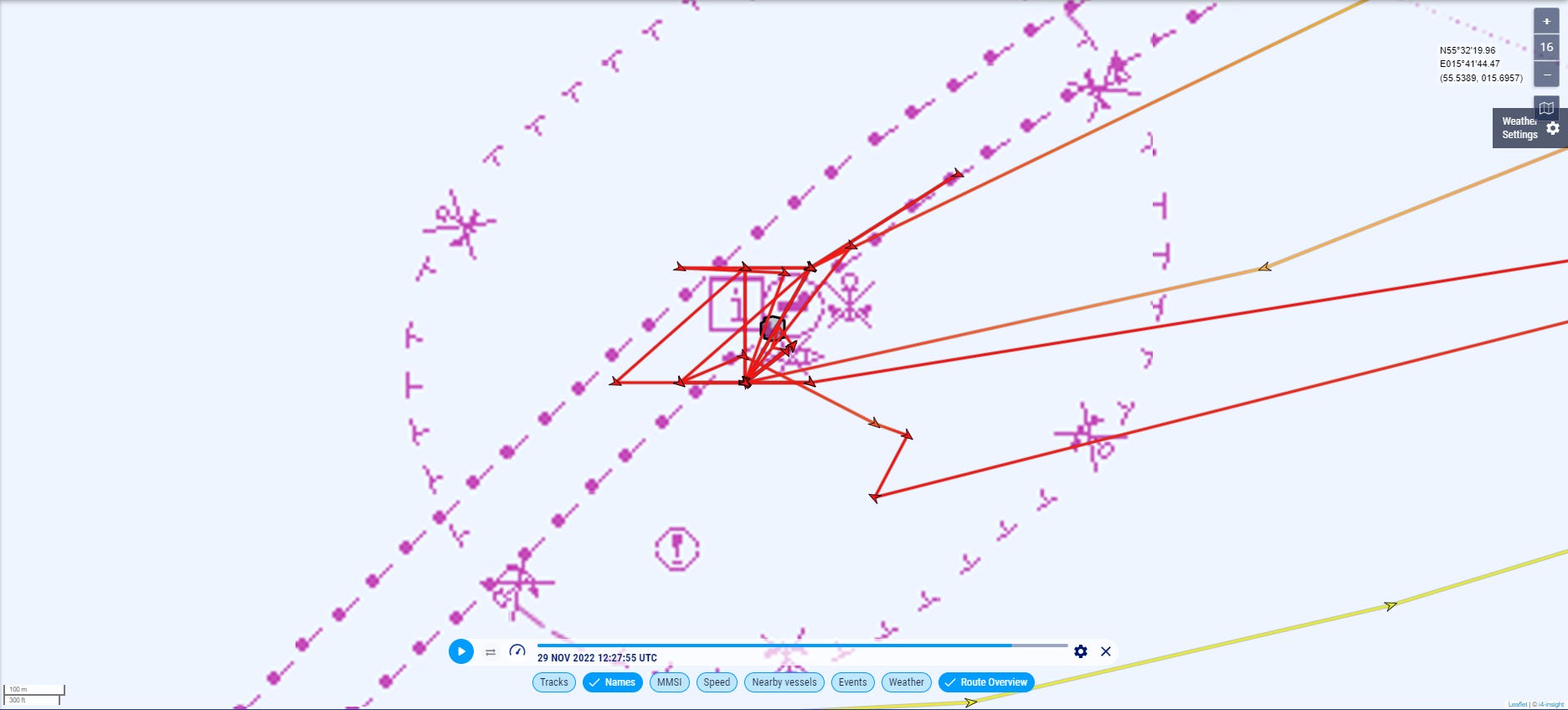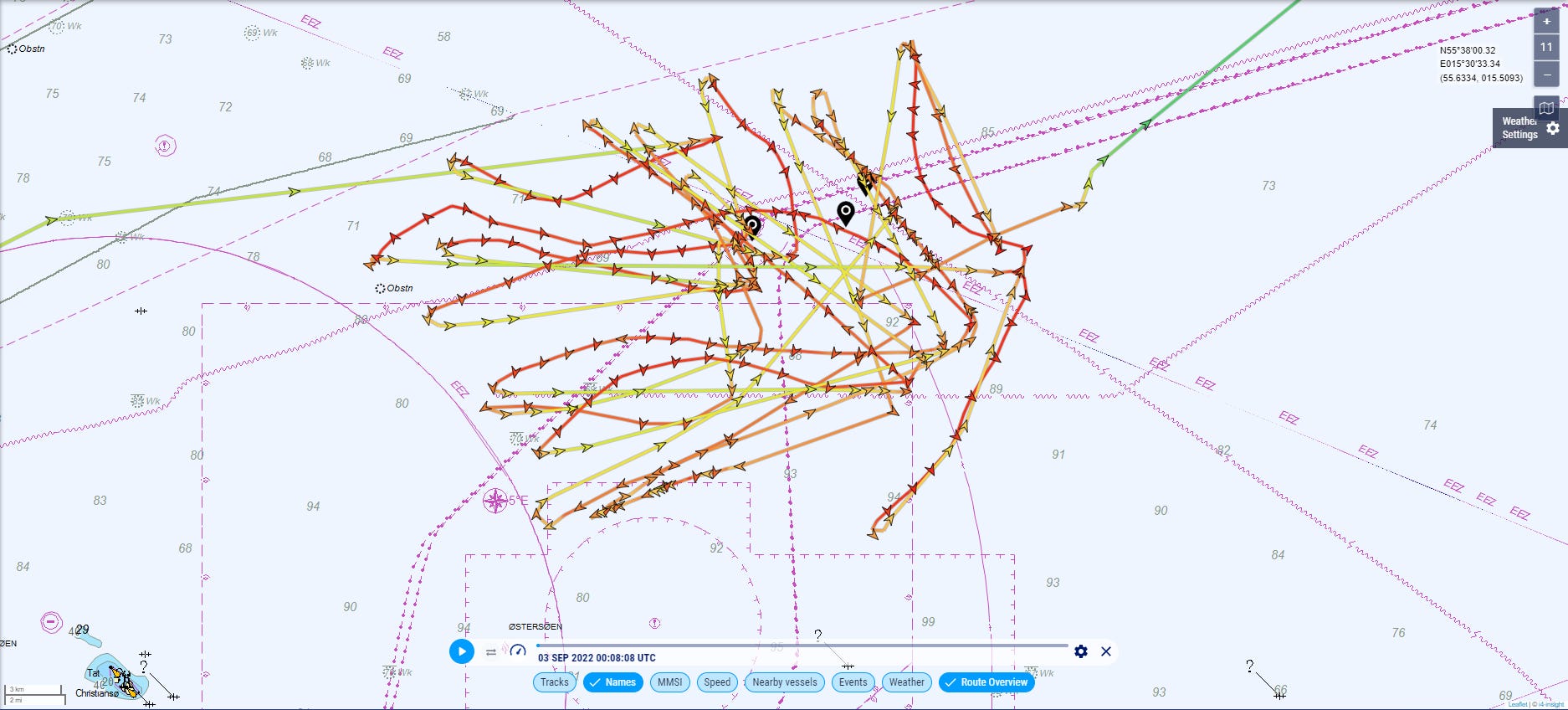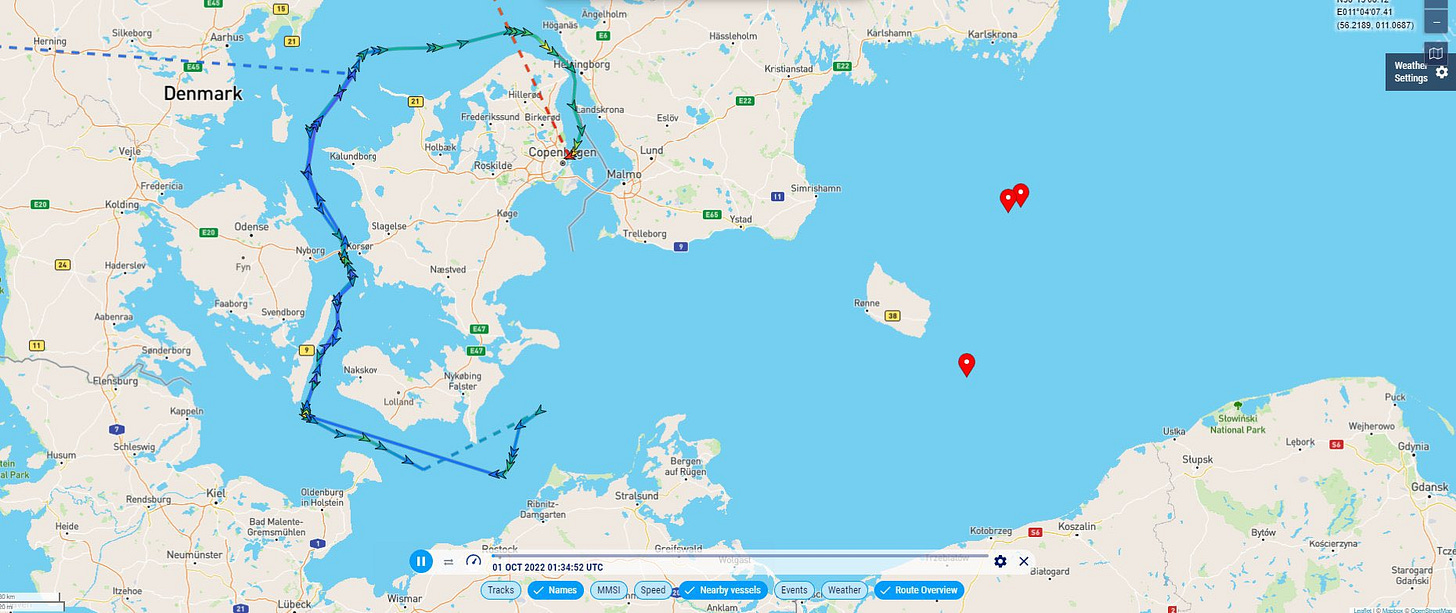Is the Akademik Cherskiy to Blame for the Southern Nord Stream 2 Rupture?
A look at the evidence for the hypothesis that the southern Nord Stream 2 rupture was an accidental catalyst that forcibly accelerated a plan to destroy the Nord Stream pipeline.
If you enjoy my content, please consider supporting my work here and on Twitter with a premium Substack subscription.
While digging through mountains of Nord Stream data as part of my series debunking Seymour Hersh’s claims of a top secret US-Norwegian mission to destroy the Nord Stream pipelines during BALTOPS22, I discovered some information that may provide an alternative theory.
As previously stated, this is a hypothesis in progress and as such as new information is discovered, the hypothesis will change. While doing more research I found information that “debunked” my previous hypothesis of the Pioneering Spirit being the culprit responsible for the poor workmanship that may have resulted in the Southern Nord Stream 2 leak. At the same time though, I have found more corroborating evidence pointing to the fact that poor workmanship was in fact to blame for the Southern NS2 leak.
Here is my updated hypothesis with the newly acquired information gathered through additional research.
Since September, the single Nord Stream 2 explosion ∼80km away from the two following Nord Stream 1 blasts has puzzled me. Not only was it ∼80km away from the other blasts, it happened 17 hours prior at 02:03 local time on September 26th.
I have continuously been looking for a possible explanation for this, and I may have found one while staring at AIS data on MarineTraffic. The navigational warning locations, just gave a rough idea of the locations of the leaks, but could not be used to identify which pipe had been ruptured at which location. I believe that I have located the exact location of all the Nord Stream leaks, as well as which pipe ruptured where. This was done by using AIS data to track the Normand Frontier and a few other vessels that were tasked with investigations of the sites following the ruptures.
Here we see the Normand Frontier investigating the Nord Stream 1 sabotage site in the Danish EEZ. As can be seen, it is entirely focused on the southern line, especially one specific area.
Here we see the Normand Frontier investigating the Nord Stream 1 sabotage site in the Swedish EEZ. Here the vessel is entirely focused on the northern line, especially one specific area.
Here we see the Normand Frontier investigating the Southern Nord Stream 2 site off the coast of Bornholm. Here the vessel is entirely focused on the western line and very much focused on a small area of the pipe.

Here we see the Normand Frontier investigating the smaller, later discovered northern Nord Stream 2 leak on the same pipe as the southern leak, in close proximity to the Nord Stream 1 leaks.

Having discovered this I noticed that while the location of the Pioneering Spirit during the storm on December 15th 2019 was directly over the leak location, this may in fact just be the coincidence of the century as the leak appears to be on the other line.

The ruptured line was laid by the Allseas Solitaire, which did not reach this location before December 20th 2019, after the Pioneering Spirits deviation on the December 15th.

Allseas suspended all Nord Stream 2 pipe laying activities on the 21st December 2019, following Trump signing the National Defense Authorization Act for Fiscal Year 2020 (NDAA) into law, which placed sanctions on Nord Stream 2. The NDAA has previously passed through the House of Representatives on the 11th December 2019.
The Allseas Solitaire was stationary at the above location for approximately 5 hours from 16:00 UTC to 21:00 UTC with sanctions becoming active within hours. I believe that this was when the Allseas Solitaire finished its work on Nord Stream 2 and proceeded to begin the process of abandonment of the pipe.
Approximately a year and half later, in late April 2021, the Russian flagged Akademik Cherskiy would pick up where the Allseas Solitaire left off. Here it would proceed to continue the work of laying the pipe by recovering the already laid pipe that had previously been abandoned by the Allseas Solitaire.
Prior to the Akademik Cherskiy resuming the work on Nord Stream 2 there were doubts about whether the vessel was even able to complete the Nord Stream pipeline adquitely.
"Moreover, the Akademik Cherskiy will not be able to provide the same, top-class speed of pipe-laying like Allseas’ vessels could showcase. Rather, the Cherskiy will probably not be able to lay more than about 3 km of pipe per day, and that velocity would be even further reduced if the vessel cannot use its Dynamic Positioning system but has to be positioned with anchors instead.”
Additional questions where raised about whether Russia had a crew that was skilled enough to complete work using the Akademik Cherskiy.
“Thus far, the Cherskiy reportedly has never been used in a pipelaying operation like the one that is needed to complete Nord Stream Two, leading to questions of the availability of Russian personnel who could operate the vessel for the pipe deployment”
Afterwards there were reports of the Akademik Cherskiy having a miryad of technical issues and problems during its work on the Nord Stream 2 pipline.
”Few people know that KMTUS "Akademik Chersky" had problems with the laying of the "A" line. Purely technical. He even had to go back, lift the pipe already laid on a section of several kilometers, cut it into metal and re-lay it, because inconsistencies with the requirements for tightness of the joints were found. With a design maximum laying speed of 3,15 km / day (with a wind speed of no more than 4 m / s), "Akademik Chersky" gave at most 400 m / day.”
Laying of Nord Stream 2: the problems of Akademik Chersky turned out to be a reality
While looking at the AIS tracks of the vessels investigating the Nord Stream ruptures, it also became apparent that the area the vessels were interested in was significantly smaller by the Southern Nord Stream 2 leak. The BBC expedition with the help of Blueye Robotics showed that at the Nord Stream 1 site approximately 250 meters of pipe were missing or destroyed.
If we look at the AIS track of the Glomar Worker at the southern Nord Stream 2 leak, it appears to only be doing a detailed survey of a very small sub-100 meter length of the pipe. The Glomar Worker was also only interested surveying the two Nord Stream 2 leaks, as it did not at any point survey the areas of the Nord Stream 1 leaks.
TV2 Bornholm recorded video of the NS2 pipe on the 24th November 2022. This footage showed a different damage profile to what was visible on the available footage of the NS1 sites. At the NS2 site, we have what looks like a relatively clean break at the location of the welds connecting two of the 12 meter sections of pipe together.
The footage from the NS1 site however show a great deal of deformation and damage to both the steel pipe and the concrete casing. A much different picture than above.
Theory
This brings me to my current working theory. It was in no party’s interests to destroy 3 of the 4 Nord Stream lines. It can be argued that the US/NATO had motivation to destroy all 4 lines. At the same time it can be argued that Russia had motivation to blow NS1, but not NS2. The destruction of 3 was always a mystery.
I believe explosives were planted on the two lines of Nord Stream 1, with the Minerva Julie possibly being involved in some aspect of the operation. This ship had a very strange track directly above the location of the NS1 explosions from the 5th September to 13th September while on route to Saint Petersburg. This was also directly after Russia cut gas supplies through Nord Stream 1 on August 31st 2022. The Minerva Julie left Rotterdam the following day on route towards St. Petersburg on September 1st.
There is no real evidence at this time to suggest that the Minerva Julie was directly involved in the planting of the charges on the pipeline. It is also a possibility that the Minerva Julie was not directly involved in the planting of explosives, but was ordered to maneuver over the site for the time period. This could have been done to provide as much cover, both visual and acoustic, for whatever vessel or submarine was used to place the charges. The Minerva Julie continuously sailing over the area would have made much of the possible detailed surveillance of the site impossible.

I theorize that the initial Nord Stream 2 rupture could be an accident, potentially the result poor workmanship by the Akademik Cherskiy due to an inadequate vessel and inexperienced crew.
Once this pipe had ruptured, the remaining pipes would probably be inspected to ensure that there was no risk of further leaks. This process would have revealed the explosives planted on the Nord Stream 1 pipes. Due to this the plan to potentially destroy Nord Stream 1 in the future was accelerated and the explosives were detonated 17 hours after the initial rupture at 19:03 local time.
Destroying Nord Stream 1 would allow Russia to increase pressure on Germany, while at the same time not being a massive loss, as they stated that it was “out of commission”. Russia had stated that the decreased flow and eventual shutdown of Nord Stream 1 was caused by European Union sanctions against Russia, which had resulted in technical problems they could not remedy.
This would leave the operational, but never opened Nord Stream 2 available to supply Germany with natural gas immediately after the shock of the destruction of Nord Stream 1. This is something Putin still offered Germany through the one remaining Nord Stream 2 line. Germany turned down the offer.
I believe that the charges were in place on Nord Stream 1, hoping for Germany and Europe to be in a more dire situation during the winter. They would then be blown in an attempt to pressure Europe to give up on Ukraine.
Additionally, only the Swedish government has publicly confirmed finding explosive residue on the debris found at the sites of the Nord Stream explosions. There has been no public mention of Denmark finding explosive residue specifically at the NS2 site.
On the 25th October, the US “unofficially” requested permission from Denmark to send a destroyer to inspect the NS2 leak location. I believe that the USS Roosevelt was used for this task. The USS Roosevelt entered the Baltic Sea on the 16th and left on the 27th and had its AIS off.
From the information currently available, The US was only interested in inspecting the southern NS2 leak. This makes me wonder whether the U.S. was confused about this leak. They may have had evidence of the reason behind the other leaks, but not this one.
Both Denmark and Sweden have released seismological data for the tremors recorded at the time of the leaks/explosions. There is a slight difference in how these two sets of data was recorded and published. The Danish data that was released was the data recorded at the site of the seismograph on Bornholm. The Swedish data on the other hand attempted to calculate the energy release at the actual site of the tremors. This results in two different, but similar measurements.
The Danish data reported that the first NS2 blast was recorded as a 2.3 while the following NS1 blasts were recorded as a 2.1. The Swedish data recorded the first blast at a 1.8 and the following blasts at a 2.3.
Looking at this data, the range of energy release between these measurements is relatively small.
Estimating magnitude, especially at these small scales involves a large degree of inaccuracy. In the following diagram, you can see that a 1.8 can be estimated to have the energy equivalent of anywhere from 20 to 3000kg of TNT depending on the method used.
The Nord Stream lines were 1153mm in diameter at 105 bar and a depth of ~80m. Using some rough calculations, I estimate that a sizeable rupture of the pipe would produce between 31.6MJ and 128MJ of energy depending on the size of the rupture. This is the equivalent of somewhere between ~7.6kg to 32kg of TNT.
The main mystery remains the small NS2 leak located on the 29th September approximately 1.4km from one of the NS1 blasts. I have seen no images directly of this site, so it is hard to make any conclusions. It could potentially have been damaged by the NS1 blasts, but at this time it is impossible to know from the available information.
This scenario also can help to explain why both sides of the conflict are relatively quite regarding the release of information on the investigation to the public. It is in Russia’s best interest to not mention that the NS2 leak may have been the result of poor workmanship, as this helps not leave Nord Stream AG and the operator of the Akademik Cherskiy open to liability. At the same time the West and NATO are happy continuing to state that all of the Nord Stream leaks are the result of direct sabotage.
As Russian vessels took over construction of the Nord Stream 2 pipeline as almost the exact site of the southern Nord Stream blast, it also remains a possibility that this location was rigged with explosives during construction. This would allow Russia to always have the ability to blow the Nord Stream 2 pipeline in the future, from the day they laid the pipe.

















Brilliant analysis, I think. In any case, the Hersh piece, based on a single source of unknown nationality and larded with impressive but irrelevant detail, failed the journalistic smell test from the start. Add to that Hersh’s previous ideology-loaded misfires, and the verdict here must be: False.
Oliver- my son is a Navy Diver CS.
The story that divers from the dive school did this, and it was ok because divers don’t do covert so it really wasn’t an act of war, was ridiculous on its face to anyone with knowledge of the NSW community.
The divers weren’t going to take the heat for this.
Hersch’s tale is more proof of the amateur hour that is the Nuland/Sullivan team. Enemies of America.